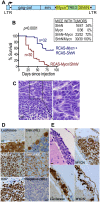BarTeL, a Genetically Versatile, Bioluminescent and Granule Neuron Precursor-Targeted Mouse Model for Medulloblastoma
- PMID: 27310018
- PMCID: PMC4911170
- DOI: 10.1371/journal.pone.0156907
BarTeL, a Genetically Versatile, Bioluminescent and Granule Neuron Precursor-Targeted Mouse Model for Medulloblastoma
Abstract
Medulloblastomas are the most common malignant pediatric brain tumor and have been divided into four major molecular subgroups. Animal models that mimic the principal molecular aberrations of these subgroups will be important tools for preclinical studies and allow greater understanding of medulloblastoma biology. We report a new transgenic model of medulloblastoma that possesses a unique combination of desirable characteristics including, among others, the ability to incorporate multiple and variable genes of choice and to produce bioluminescent tumors from a limited number of somatic cells within a normal cellular environment. This model, termed BarTeL, utilizes a Barhl1 homeobox gene promoter to target expression of a bicistronic transgene encoding both the avian retroviral receptor TVA and an eGFP-Luciferase fusion protein to neonatal cerebellar granule neuron precursor (cGNP) cells, which are cells of origin for the sonic hedgehog (SHH) subgroup of human medulloblastomas. The Barhl1 promoter-driven transgene is expressed strongly in mammalian cGNPs and weakly or not at all in mature granule neurons. We efficiently induced bioluminescent medulloblastomas expressing eGFP-luciferase in BarTeL mice by infection of a limited number of somatic cGNPs with avian retroviral vectors encoding the active N-terminal fragment of SHH and a stabilized MYCN mutant. Detection and quantification of the increasing bioluminescence of growing tumors in young BarTeL mice was facilitated by the declining bioluminescence of their uninfected maturing cGNPs. Inclusion of eGFP in the transgene allowed enriched sorting of cGNPs from neonatal cerebella. Use of a single bicistronic avian vector simultaneously expressing both Shh and Mycn oncogenes increased the medulloblastoma incidence and aggressiveness compared to mixed virus infections. Bioluminescent tumors could also be produced by ex vivo transduction of neonatal BarTeL cerebellar cells by avian retroviruses and subsequent implantation into nontransgenic cerebella. Thus, BarTeL mice provide a versatile model with opportunities for use in medulloblastoma biology and therapeutics.
Conflict of interest statement
Figures






Similar articles
-
YB-1 is elevated in medulloblastoma and drives proliferation in Sonic hedgehog-dependent cerebellar granule neuron progenitor cells and medulloblastoma cells.Oncogene. 2016 Aug 11;35(32):4256-68. doi: 10.1038/onc.2015.491. Epub 2016 Jan 4. Oncogene. 2016. PMID: 26725322 Free PMC article.
-
The miR-17/92 polycistron is up-regulated in sonic hedgehog-driven medulloblastomas and induced by N-myc in sonic hedgehog-treated cerebellar neural precursors.Cancer Res. 2009 Apr 15;69(8):3249-55. doi: 10.1158/0008-5472.CAN-08-4710. Epub 2009 Apr 7. Cancer Res. 2009. PMID: 19351822 Free PMC article.
-
Sox2 requirement in sonic hedgehog-associated medulloblastoma.Cancer Res. 2013 Jun 15;73(12):3796-807. doi: 10.1158/0008-5472.CAN-13-0238. Epub 2013 Apr 17. Cancer Res. 2013. PMID: 23596255
-
SHH desmoplastic/nodular medulloblastoma and Gorlin syndrome in the setting of Down syndrome: case report, molecular profiling, and review of the literature.Childs Nerv Syst. 2016 Dec;32(12):2439-2446. doi: 10.1007/s00381-016-3185-0. Epub 2016 Jul 21. Childs Nerv Syst. 2016. PMID: 27444290 Review.
-
Childhood tumors of the nervous system as disorders of normal development.Curr Opin Pediatr. 2006 Dec;18(6):634-8. doi: 10.1097/MOP.0b013e32801080fe. Curr Opin Pediatr. 2006. PMID: 17099362 Review.
Cited by
-
Continuous and bolus intraventricular topotecan prolong survival in a mouse model of leptomeningeal medulloblastoma.PLoS One. 2019 Jan 4;14(1):e0206394. doi: 10.1371/journal.pone.0206394. eCollection 2019. PLoS One. 2019. PMID: 30608927 Free PMC article.
-
Developmental stage-specific proliferation and retinoblastoma genesis in RB-deficient human but not mouse cone precursors.Proc Natl Acad Sci U S A. 2018 Oct 2;115(40):E9391-E9400. doi: 10.1073/pnas.1808903115. Epub 2018 Sep 13. Proc Natl Acad Sci U S A. 2018. PMID: 30213853 Free PMC article.
-
GRK2 promotes growth of medulloblastoma cells and protects them from chemotherapy-induced apoptosis.Sci Rep. 2019 Sep 25;9(1):13902. doi: 10.1038/s41598-019-50157-5. Sci Rep. 2019. PMID: 31554835 Free PMC article.
-
Childhood Brain Tumors: A Review of Strategies to Translate CNS Drug Delivery to Clinical Trials.Cancers (Basel). 2023 Jan 30;15(3):857. doi: 10.3390/cancers15030857. Cancers (Basel). 2023. PMID: 36765816 Free PMC article. Review.
References
MeSH terms
Substances
LinkOut - more resources
Full Text Sources
Other Literature Sources
Molecular Biology Databases
Research Materials

